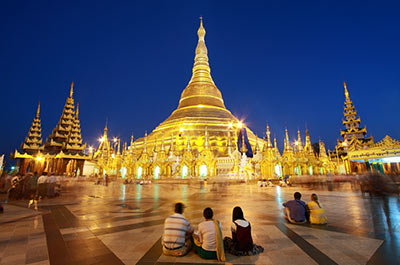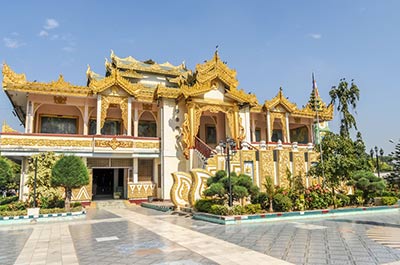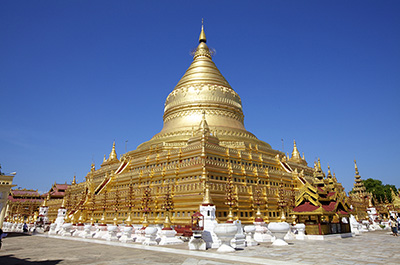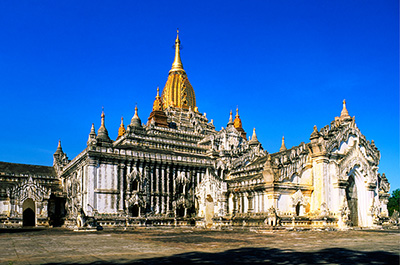Temples & pagodas of Burma
Yangon, Mandalay and other areas
The temple plays an important role in the life of most Burmese people, the vast majority of whom is Buddhist. People come to the temple to pray, offer flowers and burn incense sticks, seek the advice of a monk and for important events as cremations and Buddhist holidays. Most young men become a monk, usually for a short time. Each morning the monks leave the temple and walk through the streets with an alms bowl allowing the villagers to make merit by giving food.
Burmese style temple architecture
Buddhist temples are among the most beautiful structures in the country. Burmese temples set themselves apart from temples in neighboring countries by a number of distinct features. Typical Burmese temple architecture include the Pyatthat, the hti, delicate ornamental work metal sheets and guardian Naga serpents and Chinthe.
Naga serpents and Chinthe guardians
At the entrance gates of most Burmese temples and pagodas is usually a pair of Chinthe, mythological creatures that look like lions guarding the grounds. Naga serpents often guard the stairways to the entrance of temple buildings. The Naga is considered a protector of Buddhism, since it was Mucalinda, the King of the Nagas, that sheltered the Buddha from torrential rain when he was meditating under the Bodhi tree.
Pyatthat multi tiered roof
A Pyatthat is a heavily ornamented Burmese style multi tiered roof, each tier decreasing in size towards the top. The roof ends of Burmese temple buildings are often adorned with delicate ornamental work metal sheets.
Hti finial
Most Burmese pagodas are topped with a hti, a Burmese style finial in the shape of a multi tiered ceremonial umbrella. The hti of the most important pagodas like the Shwedagon in Yangon is made of gold and studded with diamonds or other gems.
Burma’s oldest temples and pagodas
Since countless centuries pagodas have been built to enshrine relics of the Buddha or a very important monk. Most pagodas are locked and not accessible to the public. They usually enshrine bones, teeth or one or more strands of hair.
The oldest pagodas can be found in Yangon. According to legend Burma’s oldest pagodas go back 2,500 years. The first pagodas like the Shwedagon, the Botataung and the Sule are believed to have been constructed during the lifetime of the Buddha. The original structures were much smaller than they are today. They have been renovated and enlarged many times over the centuries.
On the plains of Bagan in central Burma are the remains of thousands of temples and pagodas, built between the 11th and 13th century during the peak of the Bagan Kingdom’s power.
Famous temples, pagodas and Buddha images in Burma
Burma’s most important pilgrimage site
Burma’s most important pilgrimage site and Yangon’s most famous landmark, the Shwedagon pagoda is according to legend the oldest pagoda in the country. Its 99 meter tall gold plated stupa enshrining hair strands of the Buddha dominates the Yangon skyline.
Burma’s tallest pagoda
The tallest pagoda in the country is the 114 meter tall Shwemawdaw in Bago, constructed in the 10th century to enshrine Buddha relics.
Burma’s most highly revered Buddha image
Burma’s most highly revered Buddha image, the Mahamuni image is enshrined in the Mahamuni pagoda in Mandalay. According to legend the image was cast during the lifetime of the Buddha when he visited the Arakan Kingdom in West Burma.
The largest images of the Buddha
Across the country are a number of very large reclining Buddha images. Among them are the 65 meter long image at the Chauk Htat Gyi pagoda and the 55 meter long Shwethalyaung Buddha in Bago, which is believed to be over one thousand years old.
A very large seated image can be found at the Nga Htat Gyi pagoda in Yangon. The “five storey Buddha” measures 14 meter tall. A very recent image is the over 11 meter tall marble Buddha image of the Kyauk Taw Gyi pagoda in Yangon. The image cut from a single piece of white marble was enshrined in the pagoda in 2008.
The town of Monywa in central Burma is famous for the Monywa Buddhas. The 90 meter long reclining Buddha and the 116 meter tall standing Buddha are found on top of a hill near the town.
For an overview of the structures inside the Buddhist Wat, read temple terminology.
Buddhist temples in Burma
Temples & pagodas in Burma




